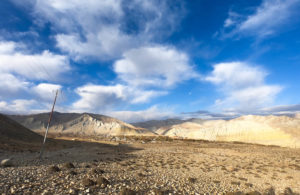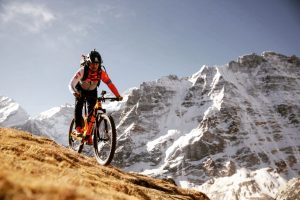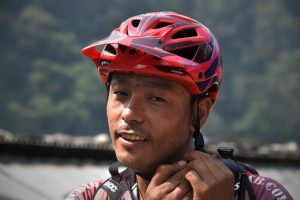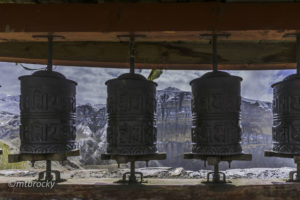Our last day in Lo Manthang was set aside for a tour of the Walled City and a visit to the Chhoser village to see the Jhong cave and the Nyphu monastery. We decided to take a walk around the city, letting our bikes take a break.
The weather in the morning was cold but sunny and windless; but afternoons would be windy, so said the charming lady owner of the Mystique Hotel, Karchyung Lhamo. Her husband, Wangchhen Lowa (better known to all as Ram Gurung) had left for work at the ACAP (Annapurna Conservation Area Project) office. With 20 years at ACAP, Ram seemed to know anything and everything about Mustang and proved a great help to me.
As we took a stroll along the street, I realised that we were outside the old Walled City as cafes, souvenir shops, more hotels lined the street. It looked times had changed. With the coming of roads from Kathmandu and Korola, the Chinese border 30km away, the once little-known ancient city that thrived as the ancient Salt Route from Tibet to India, seemed to be bounding towards the glamorous lure of modernity.
Also read: Lo Manthang: Cycling to the lost kingdom on the other side of the Himalayas
Old houses seemed replaced with modern buildings and more concrete structures for new construction stood around. Every hotel seemed to have conveniences like television and the Internet and the shops appeared well-stocked with an astonishing range of merchandise from cigarettes, rice to electronic goods–mostly Chinese.
The old part of the city within the perimeter of the wall, however, had a different story to tell. As we walked past mane-wheels and an impressive row of chortens, the street turned into a maze of narrow alleys, which led through a labyrinth of closely built white-washed mud houses still bearing antiquated windows, doors and crude stones for staircases built on the exterior. As goat skulls and Yak horns adorned the doorways, the roofs carried piles of wood stacked in a neat row.

I wondered that such places, unsullied by the trappings of development and modernity, still existed in the 3rd millennium. They spoke of a past era and stood as a silent witness to their timeless existence.
Our tour brought us to the historical wall said to be the only of its kind in Nepal. It still looked sturdy and tall, surviving the historic earthquake of 2015. They had truly stood the test of time. Built in 1440 by the first King of Lo Manthang, Ame Pal, to defend the city against enemies and trespassers, the 2,472 ft long, and 26 ft. high wall is further fortified by 14 watch towers (dzongs), 40 ft. high at strategic corners.
“Lo Manthang, in fact, is wrongly spelt by people,” said Ram Gurung. “It’s Lo (southern), Men (medicine) and thang (plains). So, it translates to “southern plains of medicine,” he explained. “Maybe, that has to do with the Tibetan healing practice of amchi–a Tibetan practice of healing, which has been a common practice in Lo for centuries. We have a clinic and school in Lo Manthang (Lo Kunphen Clinic and School), too.”
We met with a big disappointment when we went to see the 14th century Tashi Gephel Palace located right in the middle of the town. A notice at the big gate read “closed for repair and restoration”. We, however, took a walk around the 4-storeyed white-washed building and wondered at the 600-year old architecture, now succumbing to the ravages of time. To my “tashi delek,” an elderly guy who happened to be sitting by, said, “The palace sustained severe damages during the 2015 earthquake”.
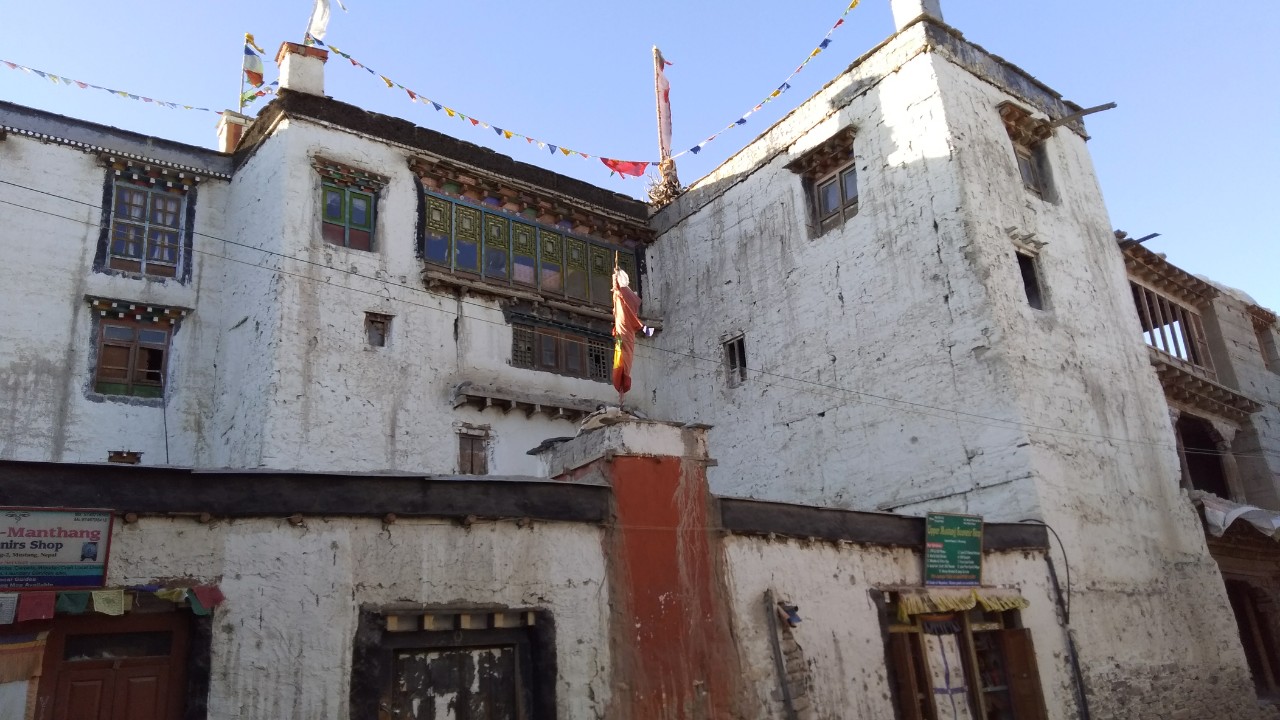
Next, we visited the historical gompas, which epitomize the rich heritage, religion, history and culture of the Lo, untouched and ageless. Almost turned into ruins, the gompas, Thubchen, Jhampa and Choede with their priceless centuries-old murals, artefacts, frescoes, images of Buddha, other deities and ancient Tibetan scriptures underwent massive repair and restoration under the patronage of the American Himalayan Foundation and the dedication of a local group, the Lo Gyalpo Jigme Foundation.
Also read: Lo Manthang: Exploring the Lost Kingdom on two wheels
Local artisans were trained and skilled carpenters were engaged for the restoration work with painstaking attention to detail. The name Luigi Feni from Rome, Italy, an aeronautical engineer turned art restorer has almost become a household name in Lo Manthang for his dedicated work (nearly 20 years) in restoring to their formal glory the mural paintings housed in those historic gompas of Lo Manthang.
Considered the oldest among the three gompas, Jhampa monastery (also called Jhampa Lakhang) built in 1387 and belonging to the Sa-skya-pa Buddhist sect is said to be a true replica of a gompa in Tibet. What are astounding are the walls within the complex in the first and the second floors, which are literally covered with tantric mandalas (said to be 1,500 in numbers) done in golden colour, some embellished with turquoise, coral, silver and gemstones.
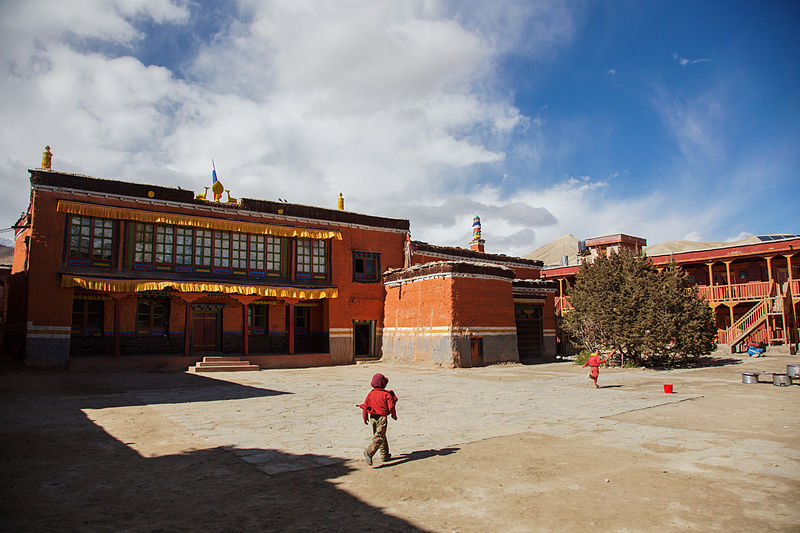
And among those works of art, a massive statue of Maitreya (Jampa Chenpo) or the future Buddha sits glowing with great solemnity rising from the ground to the first floor. The interior of the gompa with colours that dazzle the eyes and the mind speak of a resplendent work of art to a degree of excellence without comparison.
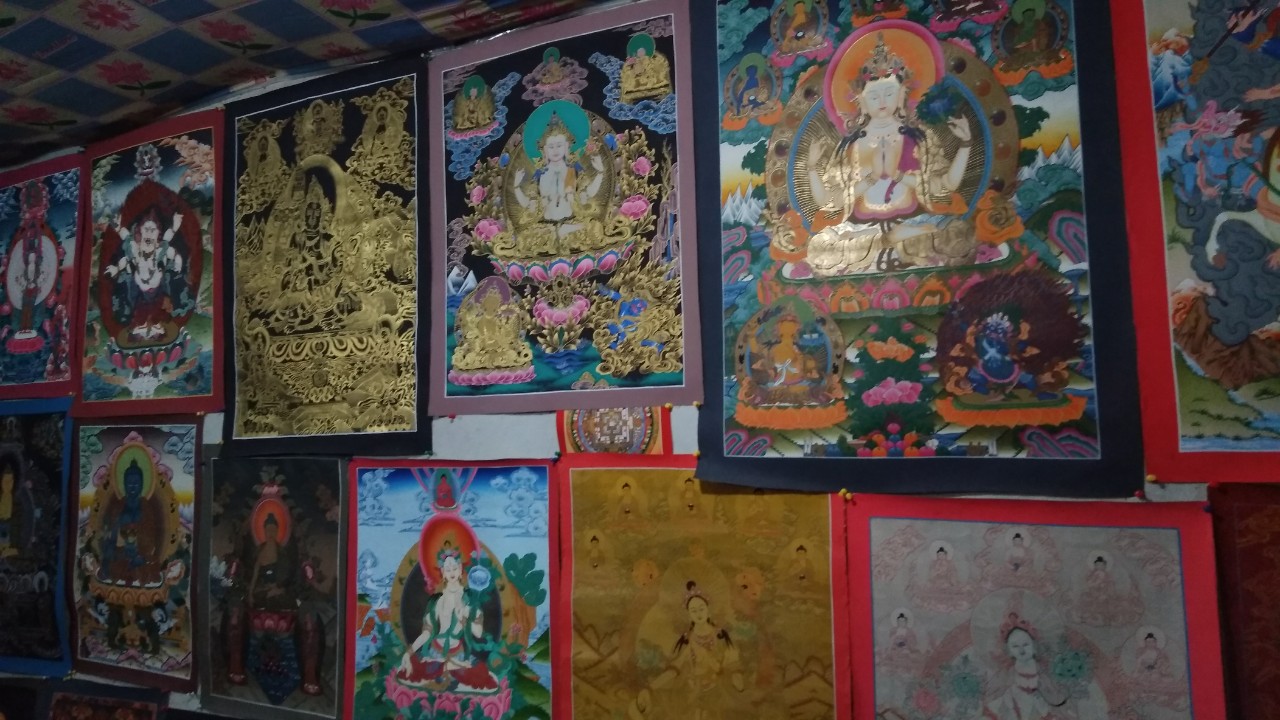
Next, the Choede Gompa founded in 1757, is highly revered by the Lowas, which also houses residence for monks and high lamas. The lamasery also includes a monastic school for young postulants seeking lamahood. The main attractions of the gompa include the images of centuries-old Mahakala and Vajra Kilaya.
Also read: Lo Manthang: The challenging ride to the land of the Lowas
Thubten Gompa, the second oldest after Jampa built in the early 15th century bears an impressive dukhang (assembly hall) with a high ceiling with the rafters engraved with the sacred Buddhist mantra, “the jewel is in the lotus” or more commonly understood as om mani pad me hum; the walls are finished in dazzling frescoes of various deities.
The visit to those gompas left us completely stumped. Honestly, I’d never seen such sublime work of art and had ‘quiet audience’ with life-size images of deities in so short a time. We were a little disappointed as photography inside the gompas was prohibited. Profoundly overwhelmed and humbled, we retraced our steps back to the hotel, the strong heady aroma of the incense from the gompas clinging to my nostrils.

As we made our way back to the hotel, watching life go by in the streets, everything seemed so laid back, as if everyone had all the time in the world. Women basked in the sun, chatting; elderly women spun yak wool; men squatted on ledges at shop fronts twirling mane-wheels; saffron-robed monks passed by leisurely thumbing prayer beads; children dashed around playfully; men and women alike herded past sheep and goats; cows roamed the streets freely, and the local women collected goat droppings and cow dung as fuel for their iron-stoves.
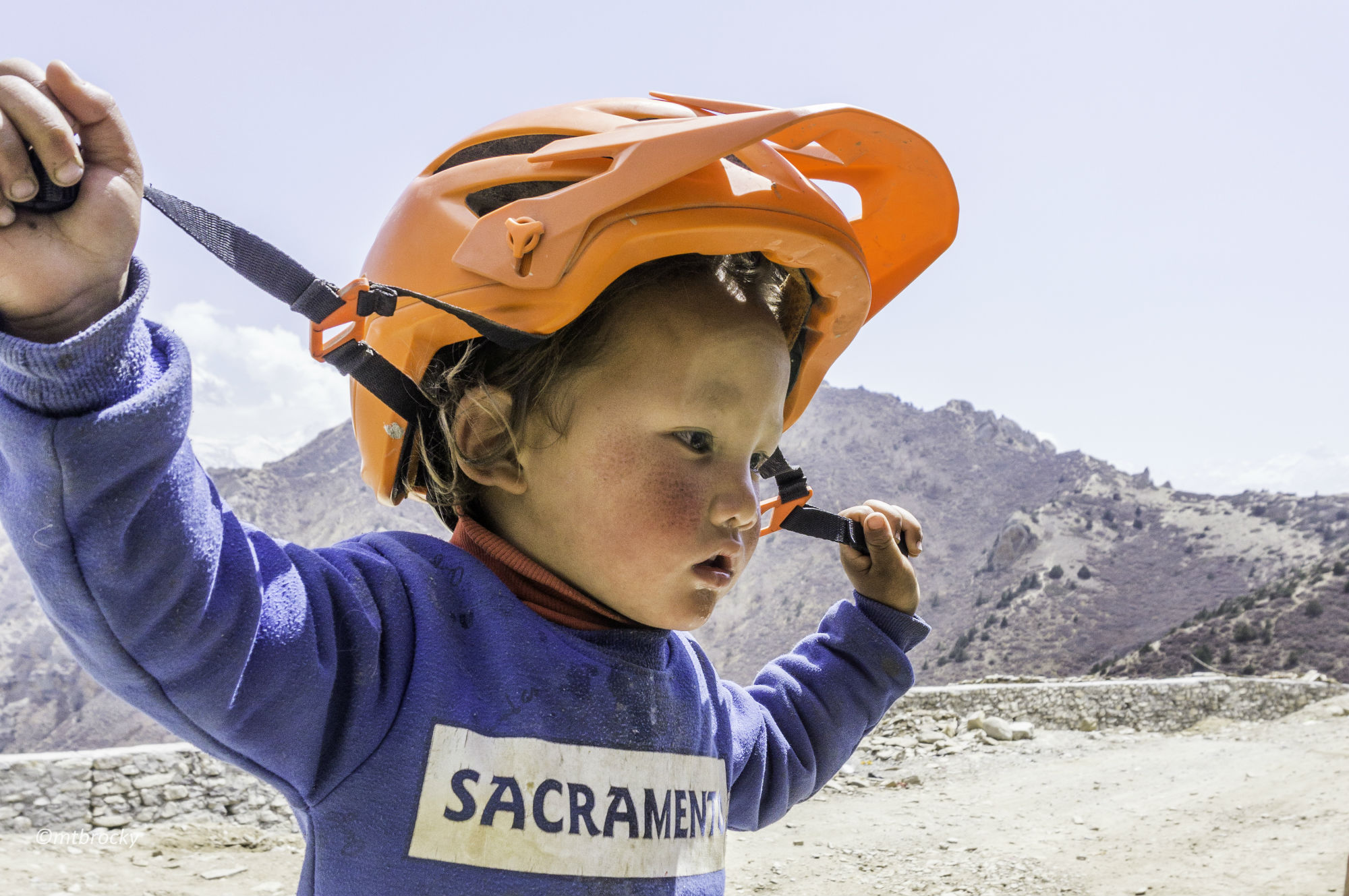
As we took the main street to our hotel, I spotted a young fellow playing some kind of an instrument . . . looked like a guitar to me. A small group watched him play. We stopped to look. That was a six-stringed Tibetan tungna dranyen (sgra-snyan) lute, which is as much an ornamental instrument as it is a musical accompaniment at local festivals.
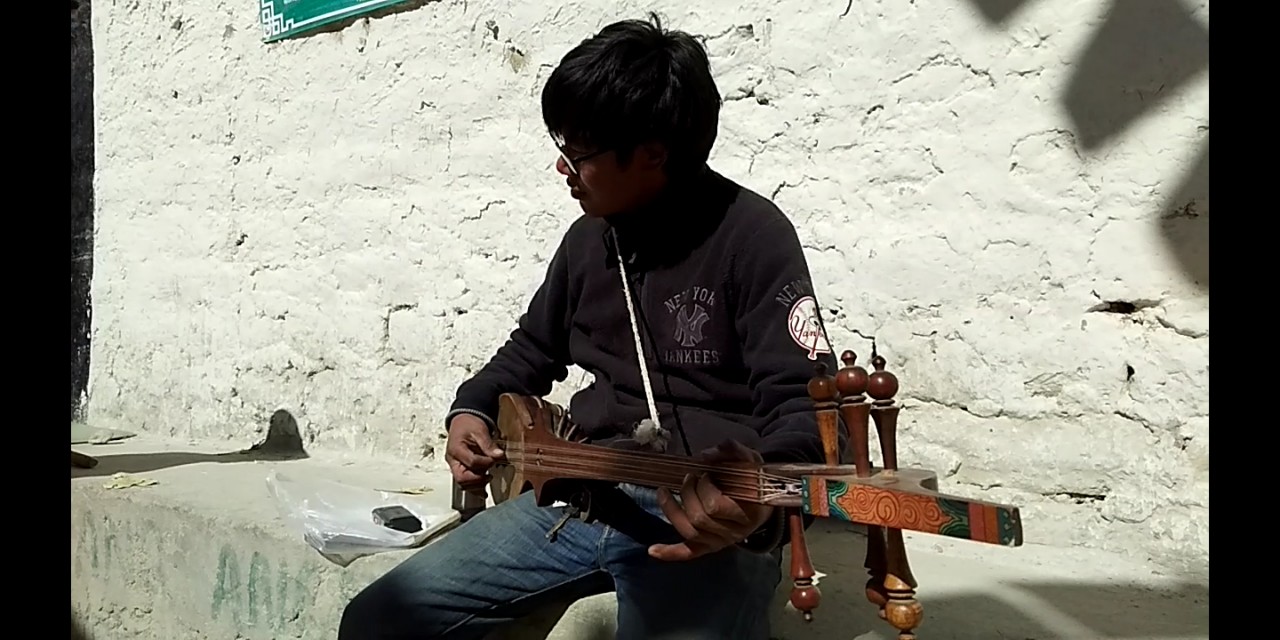 After a quick lunch at the hotel, we set off for Chosser (3,916m), eight kilometres away to see the Shija Jhong caves.
After a quick lunch at the hotel, we set off for Chosser (3,916m), eight kilometres away to see the Shija Jhong caves.
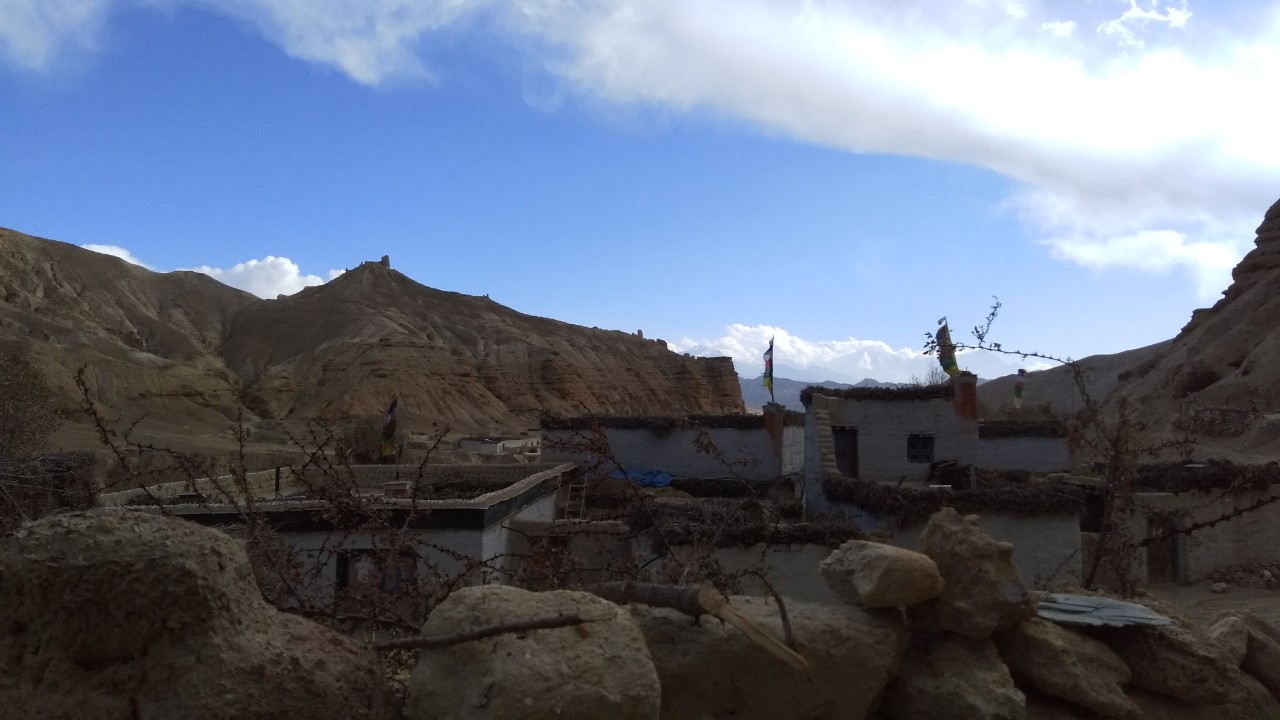
It took us a little over an hour on our bikes to arrive at Chhoser village, clusters of adobe houses scattered around. The wind had started to escalate into a full-blown gale. We chose to walk to the Jhong cave.
Since the very first day of our journey to Lo Manthang, the landscape never ceased to amaze us. It seemed it would never stop. The rock formations in weird sizes and shapes loomed all around giving us the impression of having landed on yet another other-worldly place on earth.
Also read: Dreams are meant to be lived: to the enchanting Kingdom of Lo Manthang on two wheels

Treeless and bare, the landscape looked desolate, parched, arid and cold–the wind brutal and unrelenting as ever. For all that, the charm the rugged landscape held was hard to explain.
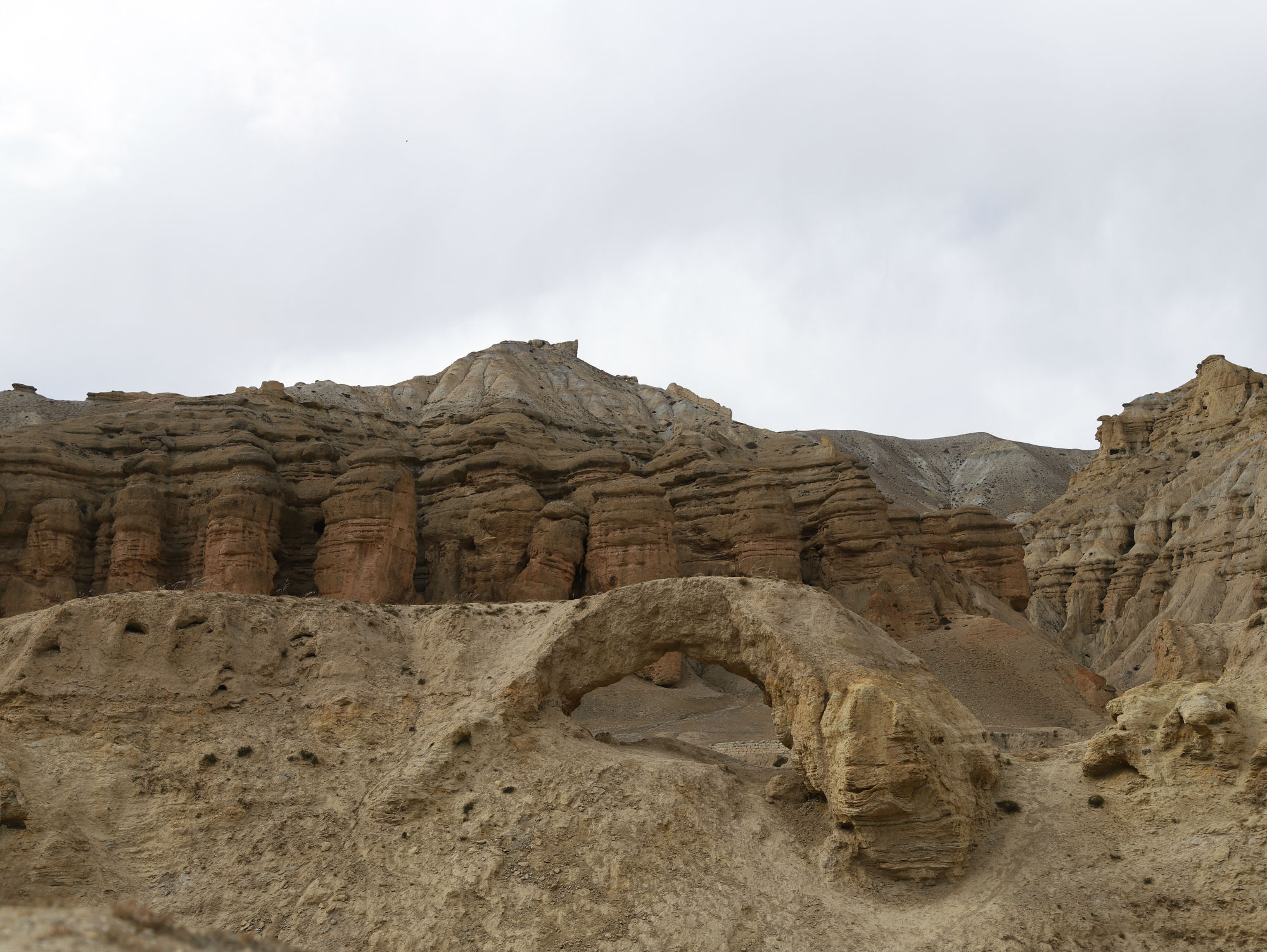
After what seemed like 45 minutes on that total wilderness, we arrived at the Jhong cave that towered above us as if trying to reach the infinite blue sky. It appeared like a flawless masterpiece done in an abstract by the greatest sculptor on earth, the Mother Nature, no less. If it would offer the geologists a fascinating subject for research, it would surely present endless mysteries for the archaeologists to unravel.
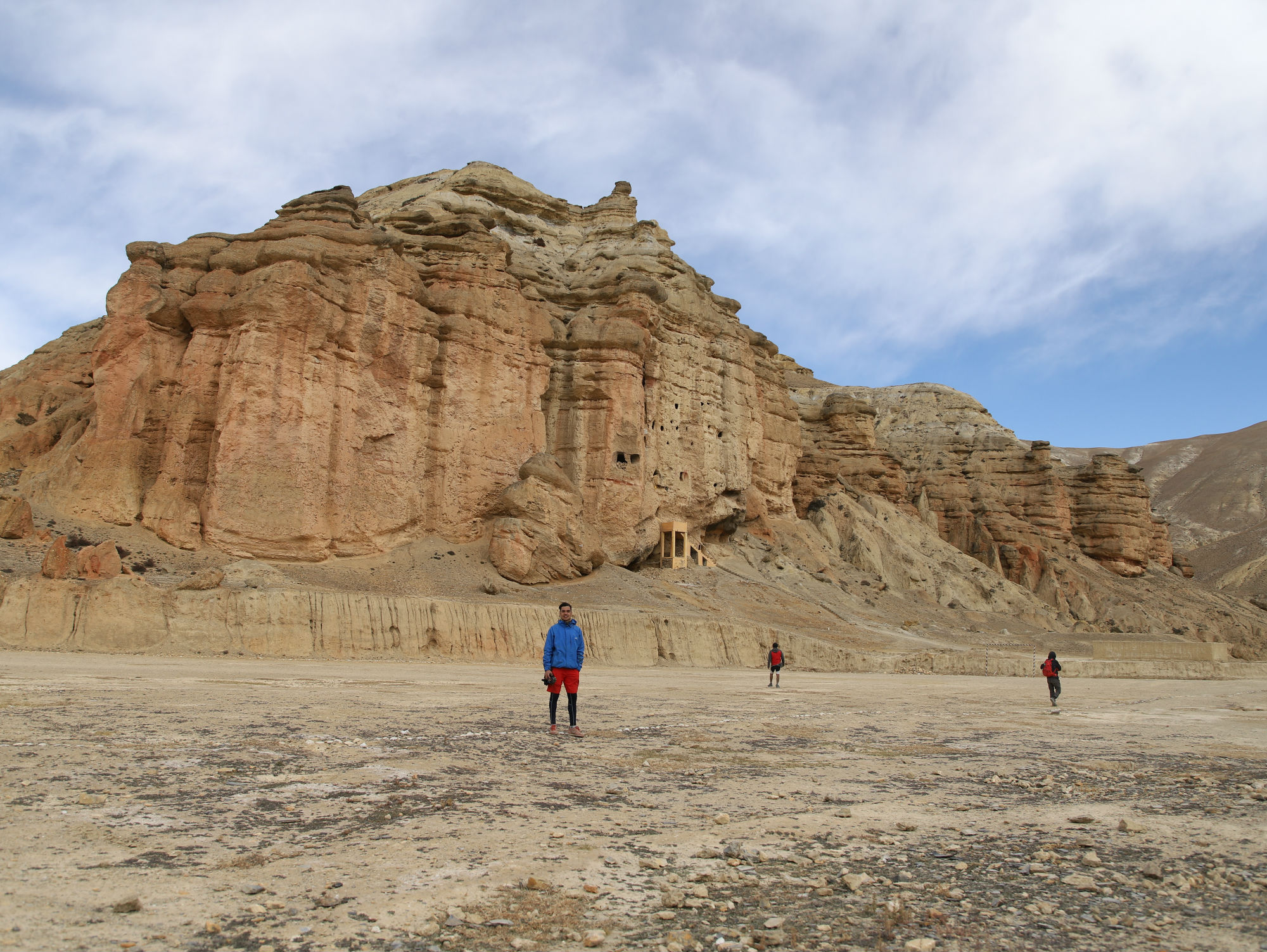
Overawed, we set foot on the 2,500 years old Shija Jhong Cave, just one among over 10,000 man-made caves that pepper the craggy cliffs of Mustang, most, near- impossible to access.
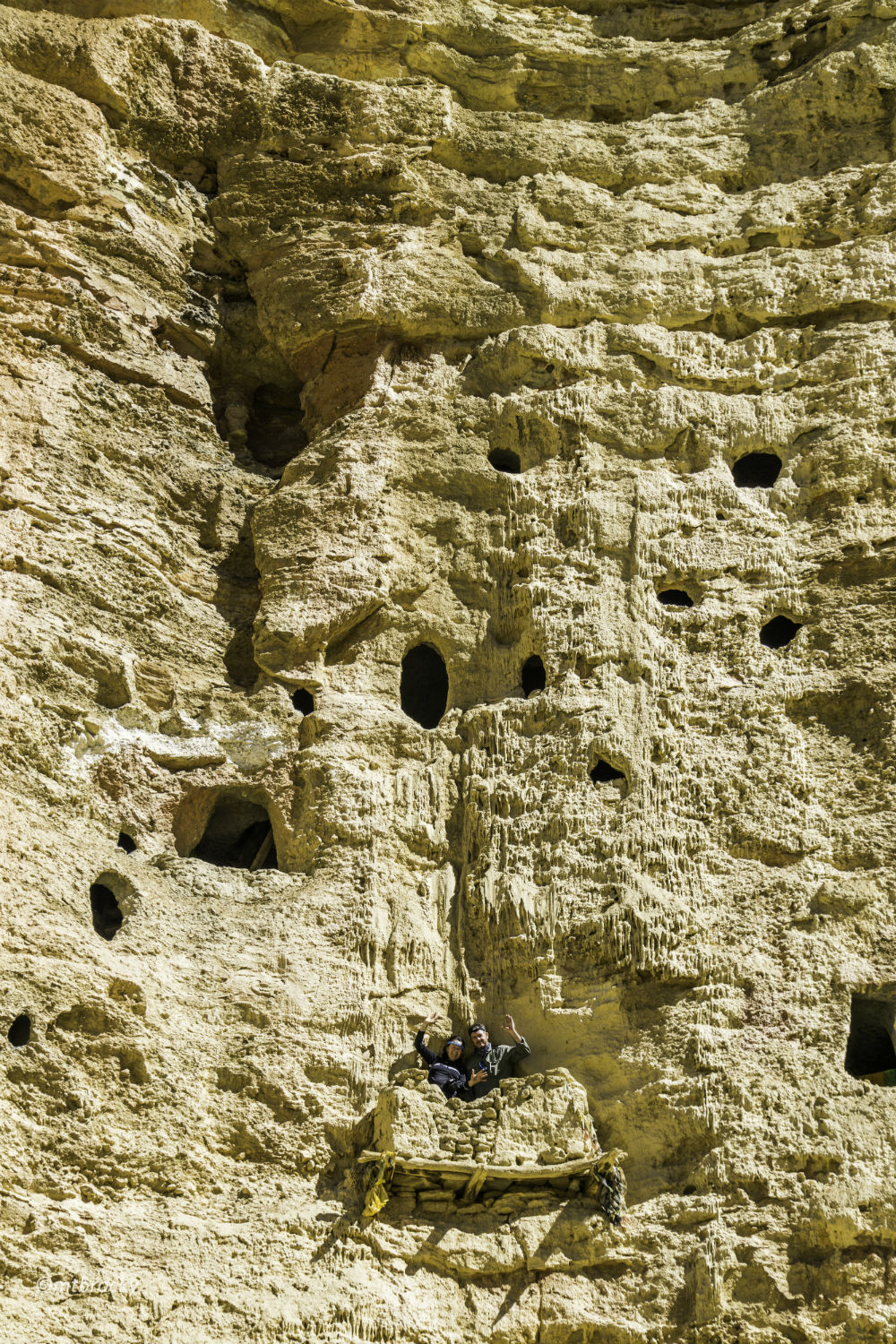
For ease of access, a flight of steps led to the entrance of the cave. After that, it was all primitive, by way of wooden ladders. The landings opened into passages and chambers. The ladders went up to a soaring fifth storey. I’d to pluck up enough courage to attempt the topmost floor as the ladder seemed to shake and wobble.

With more than 40 chambers, some had to be accessed through narrow tunnel-like entrances. And mind you, there were gaping pits too. One false step and you would take a fall to the lower storey. Some of the chambers had crude tanks and bins built into the walls for storage of water and grain; others appeared like sleeping quarters. Some had ceilings blackened by soot; must have served as kitchens.
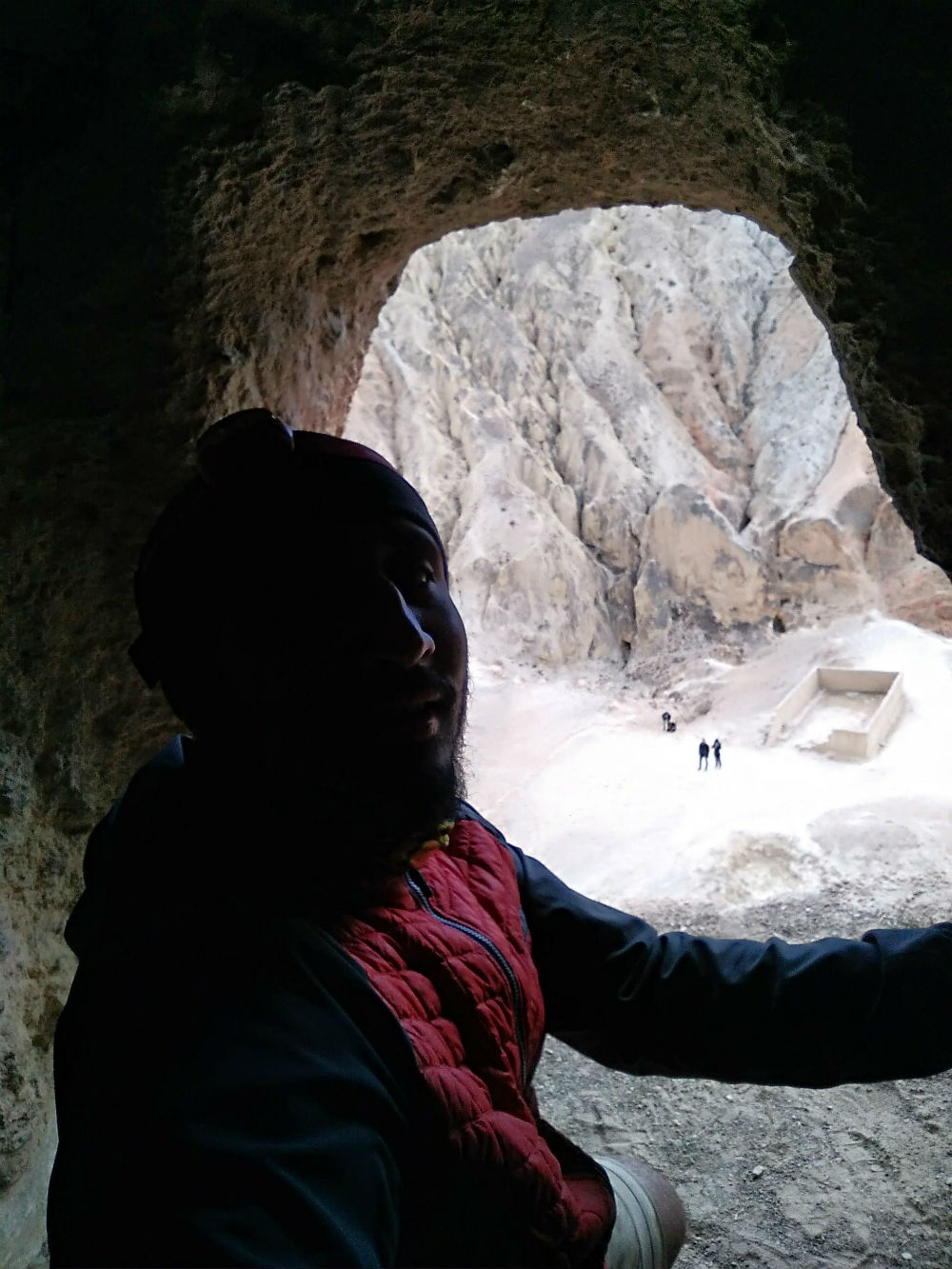
Apparently, the Jhong cave is a living testimony to people having dwelled in caves for centuries in Mustang. Nearly every chamber had a gaping hole like a porthole of an aircraft which must have served as a window. With no head for heights, it gave me the creeps even to take a peep from the gap from the fifth floor. We could even see the village of Chhoser in the distance.
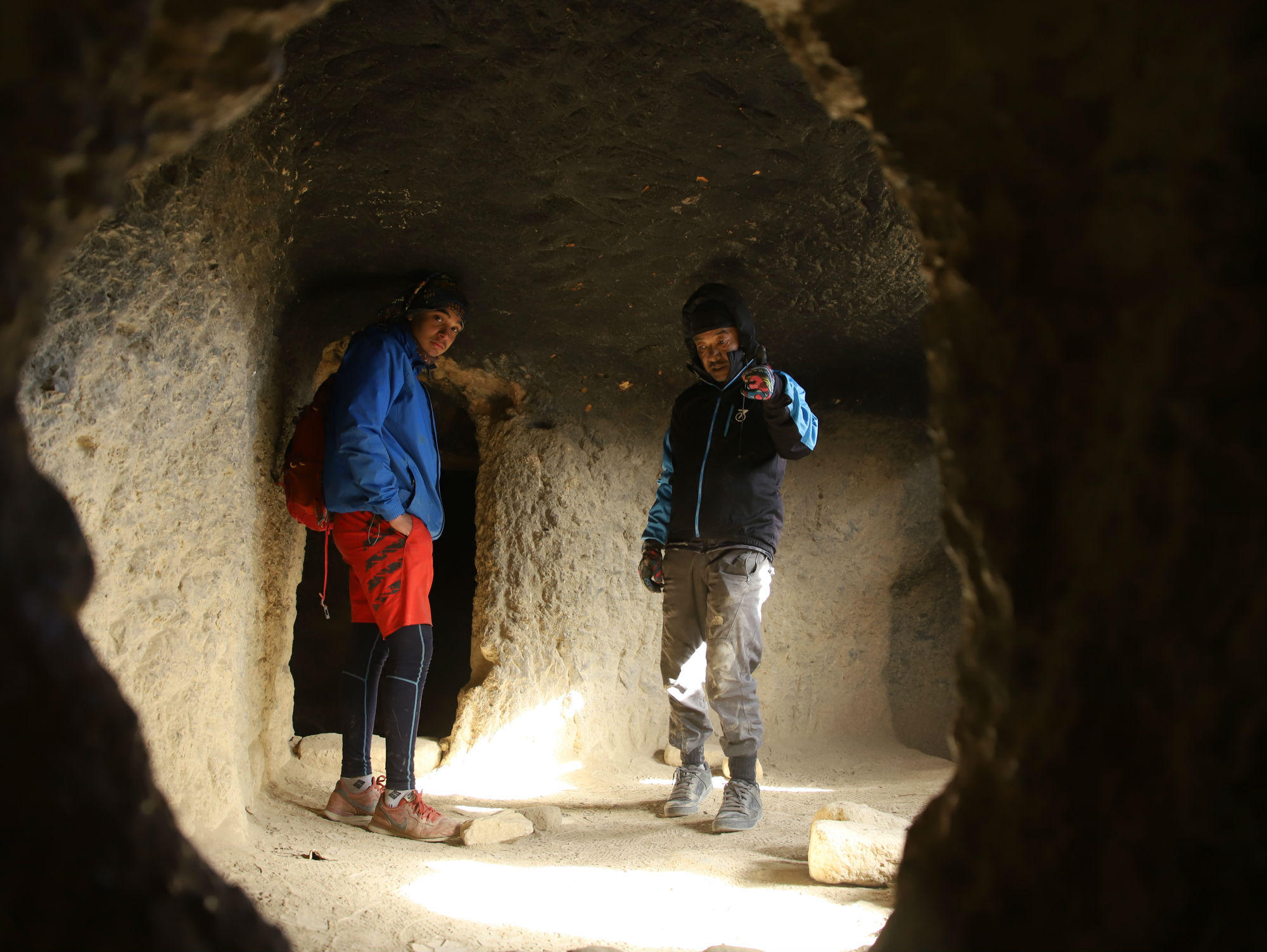
The presence of thousands of man-made sky caves dug into the sheer cliffs of Mustang substantiates that cave civilization was inseparable from its past history. “People still live in some caves around Garphu and Chosser,” said a local guy from Chosser.
Apart from being used as living quarters, archaeologists speculate that those cave shelters were used for various purposes from burial ground for the dead to meditation chambers for the monks, a refuge from enemy attack to storage and battle lookouts. Some caves like the Luri and Tashi Kabum house mural paintings and even stupas built inside.
But questions like who built those caves, how and why still baffle the archaeologists today without plausible explanations. As it is, those dark caves of Mustang remain to this day shrouded in deep mystery and intrigue.
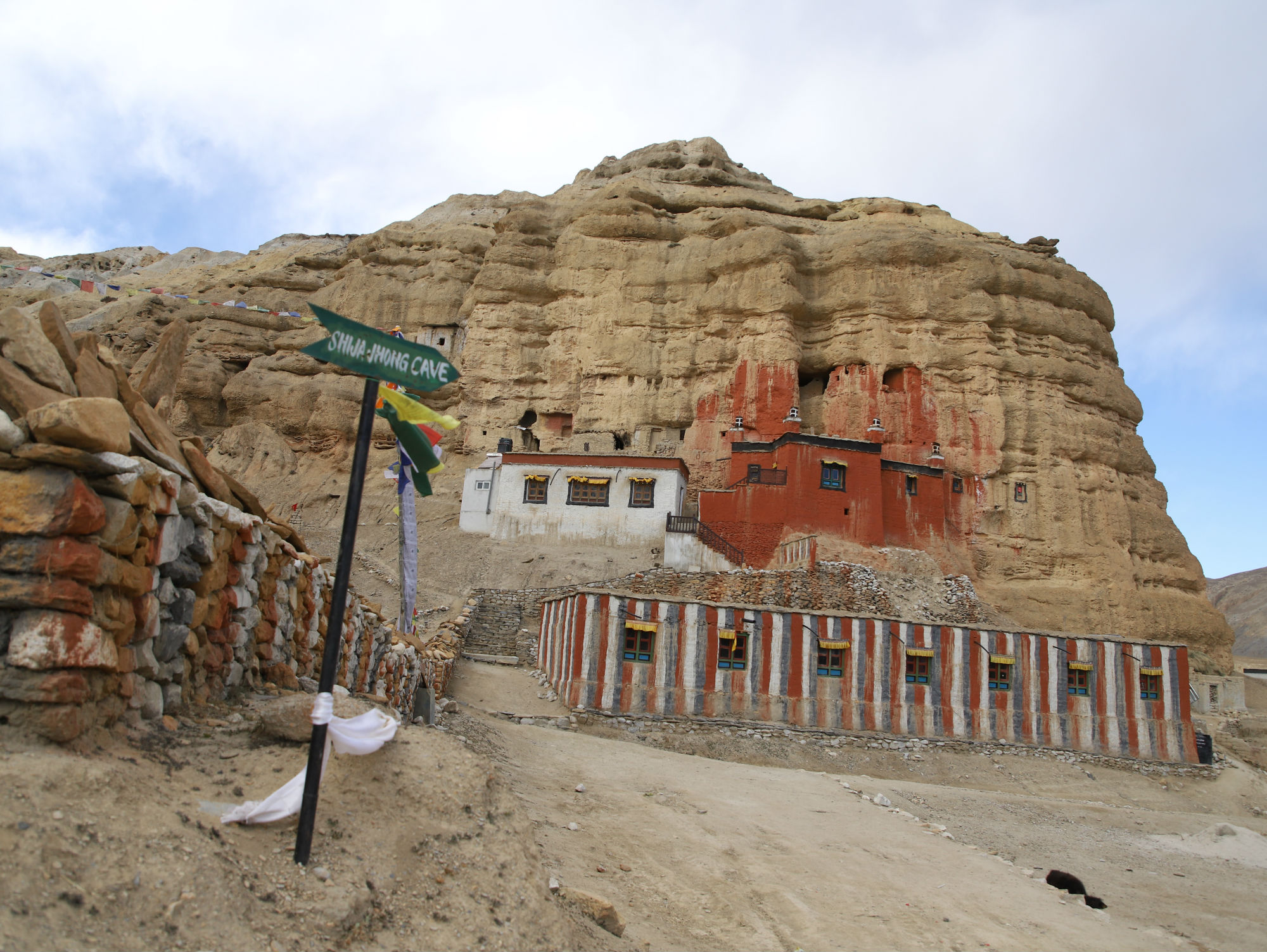
On our way back, we stopped to look at the Nymphu gompa, which made us wonder at its structure. Built into a solid rocky cliff, the gompa housed a prayer room with ornate tables and wall hangings. As oil lamps burned in one corner, a lama with eyes closed squatted on the floor before the image of Buddha. I wanted to pick up some info on the gompa but there was no one other than the monk in deep meditation. On the side of the cliff, there was a small opening into a dark cave. Again there was no one to guide us, so we headed back to Chosser.
The shadows lengthened and the sky in the horizon lit up in a tangerine hue as we ppedalledback to Lo Manthang, the cold weather and the high wind keeping us company all the way. It was already dark when we ducked into the warmth of the hotel’s dining area. I brightened up to see Ram Gurung sipping his shyu Cha (Tibetan tea) before the iron stove and joined him for a chat. My companions mingled with an Australian group of cyclists who had arrived that afternoon.
Also read: Exploring history, culture and religion in the fabled kingdom
The chat really helped me glean some vital piece of information about the Walled City, closely tied to Tibet in culture, language and geography. Also called the ‘little Tibet,’ the lost Kingdom is said to be home to the last vestiges of traditional Tibetan culture and religion, virtually unchanged since the 14th century.
With a population of only 1200 and around 900 houses, Lo in the winter (starting December through March) is literally deserted with as low as 100 inhabitants who stand to weather the harsh months with the mercury plummeting down to 20 below and the city laden with heavy snow. Save for a handful of hotels to cater for late coming tourists and stragglers, nearly all are closed.
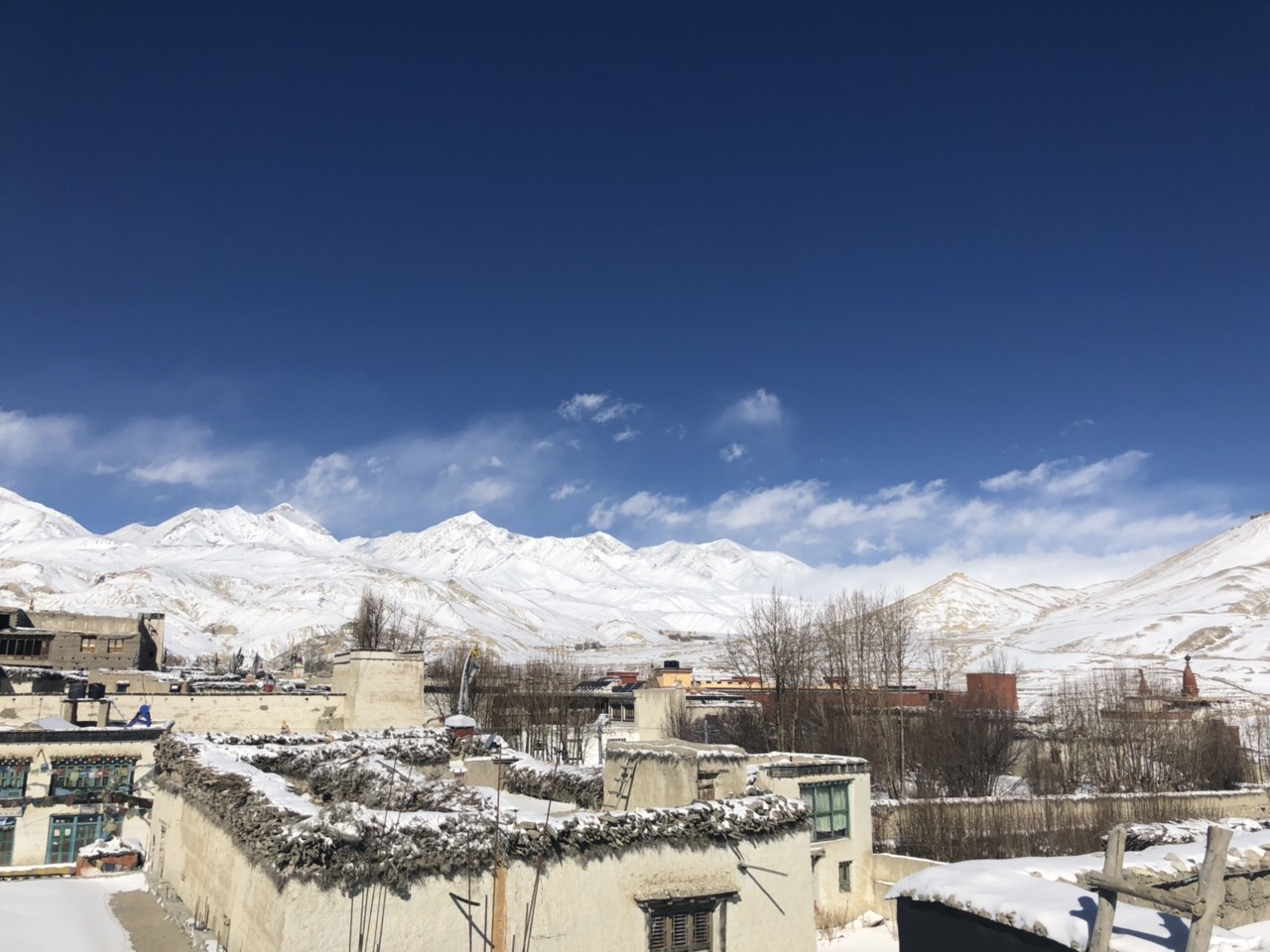
“The mass exodus to the warmer climes has been a tradition in Upper Mustang stretching back to millennia. Some go to Kathmandu or Pokhara, others to Butwal and some to India,” said Ram.
In recent years, there has been widespread speculation and growing concern over the change that has nudged itself into the once little-known walled city. People argue that the rising influx of tourists, both foreign and domestic, and the advent of roads, one from Korola, the Chinese border and the other from Kathmandu are sure to bring in its wake inevitable change.
Ram Gurung aka Wanchhen Lowa admitted that the roads had already brought change to the city but they made life easier for the people of Lo, who for centuries have been living a harsh life. He seemed, however, very optimistic about Lo’s future and shared with me that time has also brought lately a growing awareness among the young generation that they have to save their identity, heritage, and age-old traditions nurtured by their ancestors for centuries to this day.

“Lo Manthang,” Ram explained “celebrates, among others, two main festivals every year: the Tiji and the Yartung. Tiji (the triumph of good over evil or chasing of demons) is the most prestigious among all is staged for three days.”
“The Yartung (translating to summer’s end),” he continued “coincides with the harvest time and again celebrated for three days. Now, Yartung almost came to be forgotten and stopped being staged for some time in Lo Manthang. It was the youths who came to the rescue and revived the ancient custom with renewed vigor and pomp.”
With that positive vibe, I joined my friends for dinner, our last in Lo Manthang–the enchanting tiny enclave hidden within the folds of majestic mountains on the Tibetan Plateau.

Despite all the speculation and gossip, the magic of Upper Mustang will never cease. The spectacular wind-eroded cliffs, the barren ridges, the moraine valleys, the isolated mesas, the strange fluted crags, the hogbacks, the lofty escarpments, the mesmerizing hoodoos, the mysterious caves and the massive Kali Gandaki gorge under the shadows of great mountains like the Dhaulagiri, Annapurna and many others will still be there to enchant us and will continue to remain there for our posterity to enjoy.
Hopefully, the brave and forbearing Lowas will continue to persevere as the custodian of their centuries-old faith, culture, religion, priceless monuments and last not the least their spiritual identity.
End of the six-part series.
Photos:Khasing Rai, Mtb Rocky, Shayeet Sharma and Diwas Pradhan




